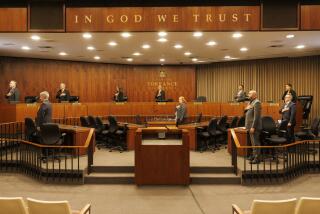Land Measure Is Called Insurance, but Also Disaster
Its supporters call it a significant step toward preserving open space and parkland in Burbank. Its opponents call it a disaster.
Measure C, one of three development-related measures on the Feb. 26 ballot, has attracted much of the attention in the Burbank municipal primary. The measure is supported by a few influential local political powers, such as veteran council member Mary Lou Howard. But most of the eight school board candidates say it would create more problems than it would solve.
The measure, which was introduced by school board candidate S. Michael Stavropoulos, would prohibit the sale or lease of public school sites, surplus school property or public parkland to anyone other than the city of Burbank. The city, in turn, could use those properties only for public parks, recreational facilities or as a land reserve for future school expansion.
Measure C would also provide policies to prevent the sale or lease of city-owned property in the city’s mountain reserve in the Verdugo Mountains.
Stavropoulos said he wrote the measure because he believed that “uncontrolled residential growth” had put a strain on schools, parks and recreational facilities. He said the city had not developed significant programs to increase parkland or recreational areas.
“I don’t want these properties sold to private builders so there will be even more development,” Stavropoulos said. “There needs to be planning and protection.”
He cited the recent sale by the district of the vacant Benjamin Franklin Elementary School to the Burbank Redevelopment Agency--which is considering selling it to a private developer--as an example of how the city was not properly planning to build or repair school facilities or increase parkland. He said he feared that the city and district were more interested in “shortsighted land deals.”
Howard, one of only two council members who support the measure, called it “an insurance policy for future generations of Burbankers that will insure the preservation of our parklands and open-space legacy.” She also said she supports Measure C over Measures A and B, the other growth-control measures on the ballot.
Measure A, among other restrictions, would place annual limits on the development of major commercial projects and the construction of multiple-unit residential projects, forbidding the building of more than 250 residential units or more than 350,000 square feet of commercial or industrial floor space per year.
Measure B would also limit high-rise development throughout the city, but does not call for caps on residential or commercial building.
The five-member Burbank City Council and the school board have formally urged voters to oppose Measure C.
“Don’t let those who are misinformed and have a hidden personal agenda take away your right to make the best use” of school property, the school board’s ballot argument says.
Stavropoulos has often clashed with the board ever since he began a fight to keep his teen-age son in district schools. The district argued successfully that he and his son lived outside the district.
Board members said the measure would tie their hands in making the best use of district property. They said they need the flexibility to make the best deal to help finance future school facilities or programs.
“If we are to make the best, most creative use of our resources, we need to keep the flexibility we have,” said board Vice President William S. Abbey, who is running for reelection. He said the district could generate more money through the sale or long-term leases of school property that was no longer needed.
“This measure takes a lot of options out of the board’s hands,” said Richard Tighe, assistant district superintendent of business services. “There are school districts who have been able to build beautiful new schools through creative financing with redevelopment agencies or through long-term lease of school property.”
He said that by leasing unneeded school property, “the board would still have it as an asset, and a nice flow of income would be coming into the district.”
He gave an example of two district-owned lots next to John Burroughs Senior High School. He said the lots were big enough for two single-family residences, but little else.
“A good use would be to sell those lots as single-family lots,” he said. “What would the city possibly want with that property? It’s not big enough for anything.”
He added that there were already enough safeguards in the state Education Code to restrict the sale of surplus school property.
The code stipulates that a citizens advisory committee must be formed to determine whether school property is really not needed by the district, Tighe said. The law also requires that the property be offered first for park and recreation use to city and county recreation departments, regional park agencies and the state Resources Agency. In addition, property to be leased must be offered for development as low- or moderate-income housing.
More to Read
Sign up for Essential California
The most important California stories and recommendations in your inbox every morning.
You may occasionally receive promotional content from the Los Angeles Times.











